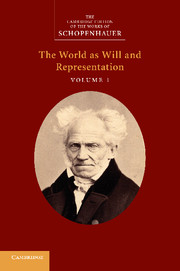Book contents
- Frontmatter
- Contents
- General editor's preface
- Editorial notes and references
- Introduction
- Notes on text and translation
- Chronology
- Bibliography
- THE WORLD AS WILL AND REPRESENTATION VOLUME 1
- Preface to the first edition
- Preface to the second edition
- Preface to the third edition
- First Book: The world as representation, first consideration. Representation subject to the principle of sufficient reason: the object of experience and science
- Second Book: The world as will, first consideration. The objectivation of the will
- Third Book: The world as representation, second consideration. Representation independent of the principle of sufficient reason: the Platonic Idea: the object of art
- Fourth Book: The world as will, second consideration. With the achievement of self-knowledge, affirmation and negation of the will to life
- Appendix: Critique of the Kantian Philosophy
- Variants in different editions
- Glossary of names
- Index
Preface to the first edition
Published online by Cambridge University Press: 06 December 2010
- Frontmatter
- Contents
- General editor's preface
- Editorial notes and references
- Introduction
- Notes on text and translation
- Chronology
- Bibliography
- THE WORLD AS WILL AND REPRESENTATION VOLUME 1
- Preface to the first edition
- Preface to the second edition
- Preface to the third edition
- First Book: The world as representation, first consideration. Representation subject to the principle of sufficient reason: the object of experience and science
- Second Book: The world as will, first consideration. The objectivation of the will
- Third Book: The world as representation, second consideration. Representation independent of the principle of sufficient reason: the Platonic Idea: the object of art
- Fourth Book: The world as will, second consideration. With the achievement of self-knowledge, affirmation and negation of the will to life
- Appendix: Critique of the Kantian Philosophy
- Variants in different editions
- Glossary of names
- Index
Summary
What I propose to do here is to specify how this book is to be read so as to be understood. – It aims to convey a single thought. But in spite of all my efforts, I could not find a shorter way of conveying the thought than the whole of this book. – I believe it is the idea that people have sought out for such a long time under the heading of philosophy, which is why scholars of history have thought it to be as impossible to discover as the philosophers' stone, although Pliny had already told them: ‘how much has been considered impossible before it has been done?’ (Natural History, 7, 1).
As this one thought is considered from different sides, it reveals itself respectively as what has been called metaphysics, what has been called ethics, and what has been called aesthetics; and it is only natural that it be all of these, if it really is what I claim it to be.
A system of thoughts must always have an architectonic coherence, i.e. a coherence in which one part always supports another without the second supporting the first, so the foundation stone will ultimately support all the parts without itself being supported by any of them, and the summit will be supported without itself supporting anything. A single thought, on the other hand, however comprehensive it might be, must preserve the most perfect unity.
Information
- Type
- Chapter
- Information
- Schopenhauer: 'The World as Will and Representation' , pp. 5 - 10Publisher: Cambridge University PressPrint publication year: 2010
